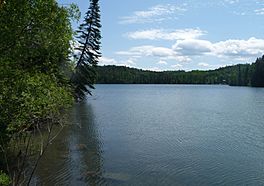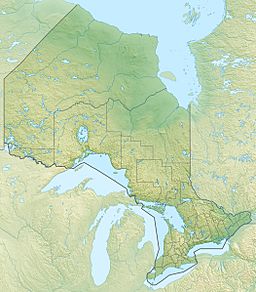Kakagi Lake facts for kids
Quick facts for kids Kakagi Lake |
|
|---|---|
| Crow Lake | |
 |
|
| Location | Kenora District, Ontario |
| Coordinates | 49°14′27″N 93°49′57″W / 49.24083°N 93.83250°W |
| Part of | Hudson Bay drainage basin |
| Basin countries | Canada |
| Max. length | 24 km (15 mi) |
| Max. width | 13.5 km (8.4 mi) |
| Surface area | 110.8 km2 (42.8 sq mi) |
| Average depth | 20.7 m (68 ft) |
| Max. depth | 54.9 m (180 ft) |
| Surface elevation | 337 m (1,106 ft) |
Kakagi Lake, also known as Crow Lake, is a beautiful lake in Northwestern Ontario, Canada. It is located in the Kenora District, near the community of Nestor Falls. This lake is part of the huge Hudson Bay drainage basin, meaning its water eventually flows into Hudson Bay. It also connects to the famous Lake of the Woods through other smaller lakes.
Contents
About Kakagi Lake
Kakagi Lake is a large body of water, covering about 110.8 square kilometers (42.8 square miles). It is about 24 kilometers (15 miles) long and up to 13.5 kilometers (8.4 miles) wide. The lake sits 337 meters (1,106 feet) above sea level. It has an average depth of 20.7 meters (68 feet) and can go as deep as 54.9 meters (180 feet).
Islands and Fun Spots
Kakagi Lake has many islands. Some of them include Gold Point Island, Green Island, and Pine Island. There are also several natural spots that people enjoy. These include Jumping Rock, Seagull Rock, and Soft Sand Beach. These are great places for campers to visit.
Life Around the Lake
You will find a small number of private cabins, mostly in an area called Young's Bay. There are also several fishing lodges and resorts. In winter, Kakagi Lake becomes a starting point for snowmobile trails. These trails connect to other lakes and go almost 60 kilometers (37 miles) east of Nestor Falls. Young's Bay is named after Clyde Young, who started Crow Lake Camp in 1932.
History and Local Connections
The Ojibways of Onigaming First Nation have a strong connection to Kakagi Lake. Their Sabaskong Bay 35D reserve is located on the southwest shore of the lake. The area around the lake also has a history of gold mining.
Fish and Wildlife in Kakagi Lake
Kakagi Lake is well known for its excellent lake trout fishing. This is because the lake has many places where these fish can lay their eggs, called spawning reefs. It also has deep water areas that trout love. Other fish that live in Kakagi Lake include muskellunge (often called musky), smallmouth bass, northern pike, and lake whitefish.
Forage Fish
The lake also has "forage fish." These are smaller fish that bigger fish eat. Some of the forage fish in Kakagi Lake are perch, rock bass, cisco, and lake shiners. There are also many other types of minnows.
Fun Activities at Kakagi Lake
Kakagi Lake Canoe Route
There is a popular canoe route called the Kakagi Lake-Cameron Lake canoe route. This loop is considered moderately difficult. It starts and ends right at Kakagi Lake. The entire route is 51 kilometers (32 miles) long and usually takes about four days to complete. Along the way, you will need to carry your canoe over land at five different spots, called portages.
You can see interesting things like ancient pictographs (rock paintings) and bald eagles on Stephen Lake, which is part of the route. The journey typically begins at the Government Dock. From there, you paddle north to Emm Bay, then through a narrow passage to Cedartree Lake. You continue through a river to Flint Lake, and then to Stephen Lake. After exploring Stephen Lake, you move into Cameron Lake. Finally, a long portage brings you back to Kakagi Lake. You then paddle along the north shore, heading west, until you return to the Government Dock.


